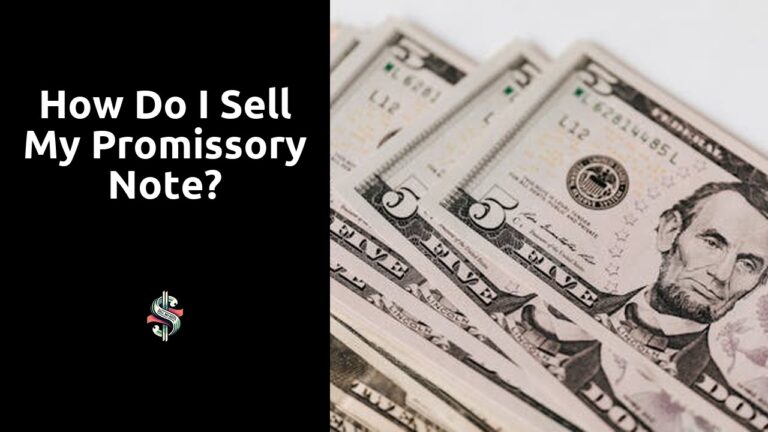How does note selling work?
Table Of Contents
Transferring Ownership
When considering note selling, transferring ownership is a crucial step in the process. This involves legally transferring the rights of the promissory note from the original note holder to the new buyer. To achieve this, a formal agreement must be drafted to outline the terms of the transfer and ensure both parties are in agreement. The transfer of ownership must be properly documented and signed by both parties to make the transaction legally binding and enforceable.
It is essential to clearly outline the details of the note transfer, including the amount being paid for the note, any interest rates involved, and the timeline for payment. Moreover, all relevant information regarding the promissory note, such as the original terms and conditions, should be included in the transfer documentation. By following the necessary steps to transfer ownership correctly, both the seller and the buyer can avoid any potential disputes or legal issues in the future.
Completing the Note Transfer Process
Once you have found a buyer for your promissory note, it is essential to complete the note transfer process correctly. This involves gathering all necessary documents related to the note, including the original promissory note, any amendments or modifications, and the payment history. Providing a clear and organized package of information to the buyer will facilitate a smooth transfer of ownership.
Next, both parties need to sign a formal agreement that documents the sale of the note. This agreement should outline the terms of the sale, including the purchase price, payment schedule, and any additional conditions. It is crucial to ensure that the agreement is legally binding to protect both the seller and the buyer in case of any disputes in the future. By completing the note transfer process meticulously, both parties can proceed with confidence in the transaction.
Receiving Payment
When it comes to receiving payment for the sale of a note, it is crucial to ensure that the payment process is smooth and efficient. Once the transfer of ownership has been completed successfully, the buyer is typically responsible for issuing the payment to the seller. It is essential for both parties to agree on the payment method and timeframe in advance to avoid any misunderstandings or delays.
For the seller, it is important to verify the receipt of payment and confirm that it has been transferred correctly. This can be done by checking bank statements, online payment platforms, or any other agreed-upon payment method. On the other hand, buyers should keep records of the payment transaction and ensure that the payment has been processed according to the terms outlined in the agreement. By maintaining clear communication and documentation throughout the payment process, both parties can ensure a successful and hassle-free note selling transaction.
Ensuring Proper Payment Transfer
To ensure a smooth and proper payment transfer when selling a note, it is crucial to have a clear payment agreement in place. This agreement should outline the exact payment terms, including the total amount due, payment schedule, and any other relevant payment details. Both parties involved should carefully review and agree upon these terms to avoid any misunderstandings or disputes.
It is recommended to choose a secure payment method that provides protection for both the seller and the buyer. Using electronic funds transfer or escrow services can help safeguard the transaction and ensure that the payment is transferred securely and efficiently. By selecting a reliable payment method, sellers can have peace of mind knowing that they will receive the agreed-upon payment for the note sale.
Handling Legalities
When it comes to selling a note, it is crucial to understand the legalities involved in the process. Before proceeding with the sale, it is advisable to seek legal advice to ensure that all aspects of the transaction are in compliance with the law. This step helps in preventing any potential legal issues that may arise during or after the note transfer process.
One of the key legal implications of note selling is the need to clear any existing liens or encumbrances on the note. This ensures that the new owner will have a clear title to the note and will not be subject to any unexpected legal claims in the future. Additionally, it is important to document the sale properly to protect both the seller and the buyer in case any disputes arise down the line.
Understanding Legal Implications of Note Selling
Understanding the legal implications of note selling is crucial for both the seller and the buyer. Sellers should be aware that selling a note may have tax consequences, so consulting with a financial advisor or tax professional beforehand is recommended. Additionally, note sellers must ensure that they have the legal right to sell the note and that there are no restrictions or prohibitions against doing so.
Buyers, on the other hand, should conduct thorough due diligence before purchasing a note to avoid any potential legal pitfalls. This includes reviewing all documentation related to the note, such as the terms of the note, payment history, and any associated agreements. It is important for buyers to understand the enforceability of the note and any potential risks or liabilities that may arise from the purchase.
FAQS
What is note selling?
Note selling is the process of transferring ownership of a promissory note from the original holder to a new buyer in exchange for a lump sum payment.
How does transferring ownership of a note work?
Transferring ownership of a note involves the original note holder selling the rights to receive future payments from the borrower to a new buyer, who then assumes the responsibility of collecting those payments.
How do I complete the note transfer process?
To complete the note transfer process, both parties must agree on the terms of the sale and sign a formal agreement outlining the details of the transaction. The new buyer will then take possession of the promissory note.
How do I receive payment for selling my note?
Payment for selling a note is typically received in the form of a lump sum payment from the buyer. This payment is made at the time of the note transfer and represents the total value of the future payments due on the note.
How can I ensure proper payment transfer when selling my note?
To ensure proper payment transfer when selling your note, it is important to work with a reputable buyer and have a clear written agreement in place that outlines the payment terms and conditions. Verify the buyer’s credentials and confirm the payment before finalizing the transfer.
What legalities should I consider when selling a note?
When selling a note, it is crucial to understand the legal implications involved. Make sure to comply with all applicable laws and regulations governing the sale of promissory notes, and seek legal advice if needed to ensure a smooth and legally sound transaction.







